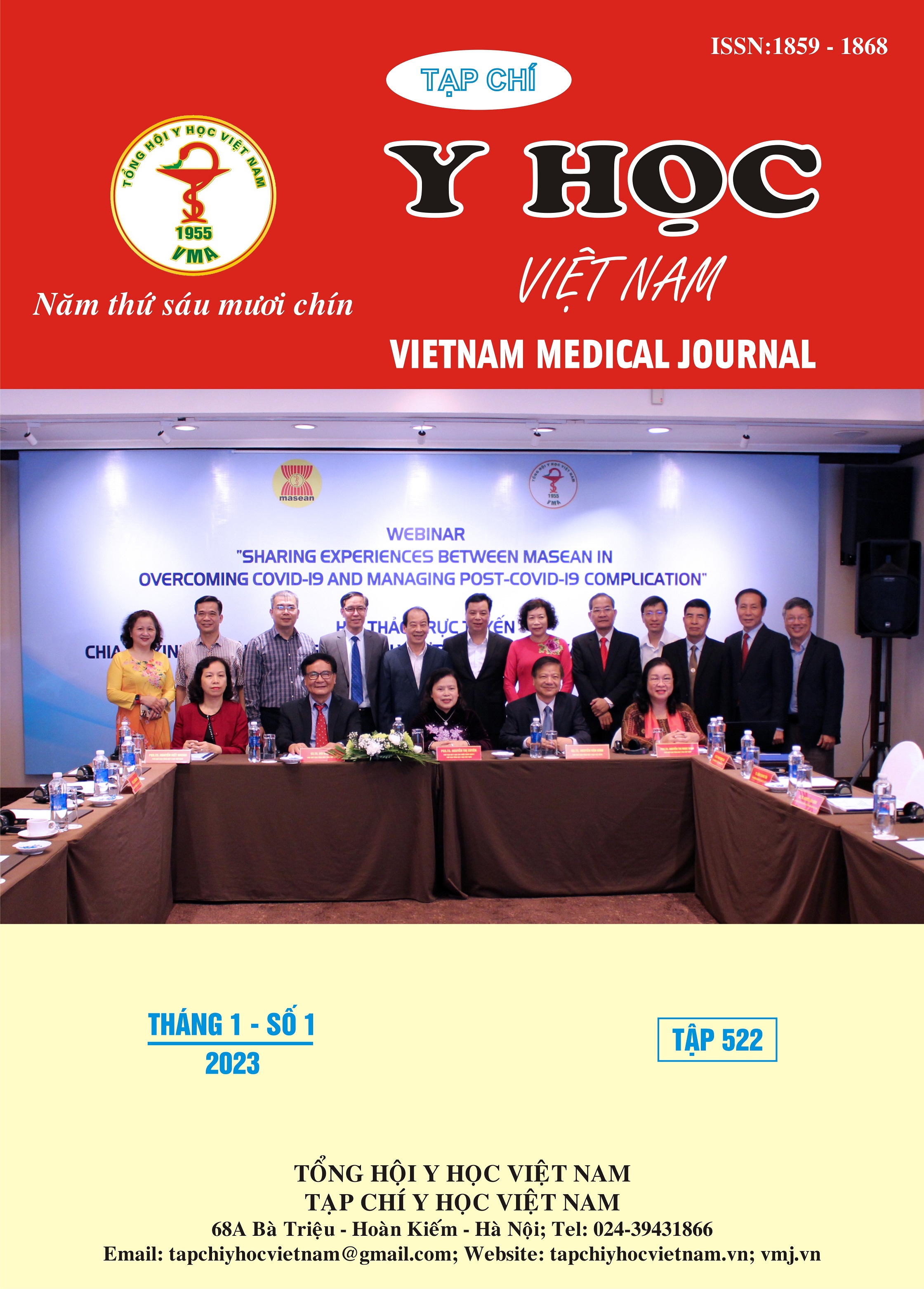PHÁT HIỆN VÀ PHÂN TÍCH ĐỊNH LƯỢNG TRỰC KHUẨN GRAM ÂM KHÁNG COLISTIN TRONG MẪU THỊT GÀ, THỊT LỢN BÁN LẺ TẠI THÁI BÌNH
Nội dung chính của bài viết
Tóm tắt
Nghiên cứu được thực hiện nhằm phát hiện và định lượng vi khuẩn Gram âm kháng colistin trong thịt gà và thịt lợn bán lẻ tại Nguyên Xá, Vũ Thư, Thái Bình. Sau khi thuần nhất, các mẫu thịt gà và thịt lợn được pha loãng trong dung dịch đệm peptone (BPW) và nuôi cấy trên môi trường Chromagar ECC (ECC) và Chromagar COL-APSE (COL-APSE) trong điều kiện 37oC trong 18 – 24 giờ. Căn cứ vào màu sắc khuẩn lạc để phân loại vi khuẩn và xác định mật độ các loại vi khuẩn nhiễm trong các mẫu thịt. Đối với mỗi mẫu thịt lựa chọn từ 1 – 3 khuẩn lạc đại diện cho các vi khuẩn phát triển trên môi trường COL-APSE để phân lập, xác định nồng độ ức chế tối thiểu (MIC) với colistin theo hướng dẫn của CLSI. Tỷ lệ nhiễm vi khuẩn Gram âm kháng colistin trong các mẫu thịt rất cao, ở thịt gà là 86,7% và ở thịt lợn là 73,3%. Mật độ vi khuẩn Gram âm kháng colistin trong các mẫu thịt trung bình từ 103 đến 106 CFU/g. E. coli, Acinetobacter và coliform là các vi khuẩn gây ô nhiễm trong mẫu thịt bán lẻ thường gặp. Trong số các chủng Gram âm có 77,4% số chủng là vi khuẩn kháng colistin (MIC ≥ 4 mg/L). Kết quả nghiên cứu cho thấy vi khuẩn E. coli và coliform kháng colistin chỉ chiếm một tỷ lệ nhỏ (dưới 10%) trong số các vi khuẩn E. coli và coliform nhiễm trong các mẫu thịt. Tình trạng nhiễm vi khuẩn Gram âm kháng colistin ở thịt gà, thịt lợn bán lẻ xảy ra khá phổ biến tại Thái Bình, do đó cần thực hiện các biện pháp vệ sinh an toàn thực phẩm phù hợp để ngăn chặn sự lây lan của vi khuẩn kháng colistin trong cộng đồng.
Chi tiết bài viết
Từ khóa
kháng colistin, phân tích định lượng, thịt bán lẻ, vi khuẩn Gram âm
Tài liệu tham khảo
1. Catry, B., Cavaleri, M., Baptiste, K., et al. (2015). Use of colistin-containing products within the European Union and European Economic Area (EU/EEA): development of resistance in animals and possible impact on human and animal health. International journal of antimicrobial agents, 46(3), 297–306.
2. Kasiakou, S. K., Michalopoulos, A., Soteriades, E. S., et al. (2005). Combination therapy with intravenous colistin for management of infections due to multidrug-resistant Gram-negative bacteria in patients without cystic fibrosis. Antimicrob Agents Chemother, 49: 3136-46.
3. Kawahara, R., Fujiya, Y., Yamaguchi, T., et al. (2019). Most Domestic Livestock Possess Colistin-Resistant Commensal Escherichia coli Harboring mcr in a Rural Community in Vietnam. Antimicrobial agents and chemotherapy, 63(6), e00594-19.
4. Liu, Y. Y., Wang, Y., Walsh, T. R., et al. (2016). Emergence of plasmid-mediated colistin resistance mechanism MCR-1 in animals and human beings in China: a microbiological and molecular biological study. The Lancet. Infectious diseases, 16(2), 161–168.
5. Nakayama, T., Jinnai, M., Kawahara, R., et al. (2017). Frequent use of colistin-based drug treatment to eliminate extended-spectrum beta-lactamase-producing Escherichia coli in backyard chicken farms in Thai Binh Province, Vietnam. Tropical animal health and production, 49(1), 31–37.
6. Shen, Y., Zhang, R., Schwarz, S., et al. (2020). Farm animals and aquaculture: significant reservoirs of mobile colistin resistance genes. Environmental microbiology, 22(7), 2469–2484.
7. Van Cuong, N., Nhung, N. T., Nghia, N. H., et al. (2016). Antimicrobial Consumption in Medicated Feeds in Vietnamese Pig and Poultry Production. EcoHealth, 13(3), 490–498.
8. Yamamoto, Y., Kawahara, R., Fujiya, Y., et al. (2019). Wide dissemination of colistin-resistant Escherichia coli with the mobile resistance gene mcr in healthy residents in Vietnam. The Journal of antimicrobial chemotherapy, 74(2), 523–524.
2. Kasiakou, S. K., Michalopoulos, A., Soteriades, E. S., et al. (2005). Combination therapy with intravenous colistin for management of infections due to multidrug-resistant Gram-negative bacteria in patients without cystic fibrosis. Antimicrob Agents Chemother, 49: 3136-46.
3. Kawahara, R., Fujiya, Y., Yamaguchi, T., et al. (2019). Most Domestic Livestock Possess Colistin-Resistant Commensal Escherichia coli Harboring mcr in a Rural Community in Vietnam. Antimicrobial agents and chemotherapy, 63(6), e00594-19.
4. Liu, Y. Y., Wang, Y., Walsh, T. R., et al. (2016). Emergence of plasmid-mediated colistin resistance mechanism MCR-1 in animals and human beings in China: a microbiological and molecular biological study. The Lancet. Infectious diseases, 16(2), 161–168.
5. Nakayama, T., Jinnai, M., Kawahara, R., et al. (2017). Frequent use of colistin-based drug treatment to eliminate extended-spectrum beta-lactamase-producing Escherichia coli in backyard chicken farms in Thai Binh Province, Vietnam. Tropical animal health and production, 49(1), 31–37.
6. Shen, Y., Zhang, R., Schwarz, S., et al. (2020). Farm animals and aquaculture: significant reservoirs of mobile colistin resistance genes. Environmental microbiology, 22(7), 2469–2484.
7. Van Cuong, N., Nhung, N. T., Nghia, N. H., et al. (2016). Antimicrobial Consumption in Medicated Feeds in Vietnamese Pig and Poultry Production. EcoHealth, 13(3), 490–498.
8. Yamamoto, Y., Kawahara, R., Fujiya, Y., et al. (2019). Wide dissemination of colistin-resistant Escherichia coli with the mobile resistance gene mcr in healthy residents in Vietnam. The Journal of antimicrobial chemotherapy, 74(2), 523–524.


